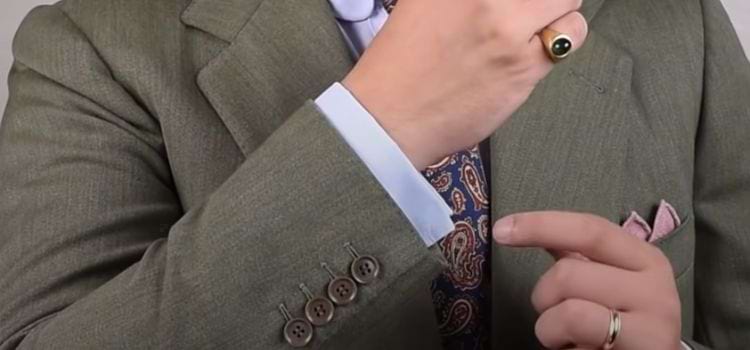As an Amazon Associate, I earn from qualifying purchases.
It is said that style is in detail, so if jacket sleeve fit is the single most important sartorial detail of your suit, it can make the difference between looking like a million dollars and simply looking like a million dollars worth of cloth. The suit jacket sleeve length is one of the last details you might think of when completing your stylish wardrobe, but, unlike a tie pin, you’re likely to leave out literally and figuratively at home, your sleeve length might well be the final detail of your suit and the first in dropout central. How to perfectly hem your suit jacket sleeve and sew a clean buttonhole to reinforce the buttonhole of your suit jacket.
So how do you do that, and get that perfect fit in the process, if you don’t have the benefit of a tailor? Well fear not, because help is at hand for all of you stylish gentlemen seeking the perfect tailored look. Below is a complete step-by-step guide to how to roll up the sleeves on your suit jacket, so that you can achieve that perfectly custom look. Whether you are taking a freshly bought suit and setting out to personalize it, or you are opening up your old wardrobe and bringing your old favorite back into service, the result will be the same and you will be rolling up the sleeves on your suit jacket in no time at all.

The Importance of Properly Fitting Suit Jacket Sleeves
Before we get to the actual ins and outs of sleeve measurement, let’s get the why right: properly cuffed suit jacket sleeves do more than hide your arms. They provide balance to your silhouette, emphasize your choice of shirt or cuff, and point to the degree of control you’ve exercised in your appearance. You’re in the middle of a handshake and, if your jacket shows too much wrist, you’ve just lost the battle for presence.
If your sleeves are too long, you might signal a lack of regard for the little things that matter – a fact that might extend to your attitude about work. A proper, turned-up cuff on your suit jacket is a subtle, yet powerful weapon in your stylish arsenal.
With that armory at your disposal, it’s time to grab a hammer (figuratively speaking) and beat the near-perfection of the sleeve length into submission. The sleeve of a good suit jacket should end just above the shirt sleeve, revealing approximately half an inch of the dress shirt cuff. So, wear the jacket over a singlet and put on a dress shirt with a suit collar.
Stand naturally and let your arms hang naturally by your sides. Note the point where your thumb joins your wrist; that is where your dress shirt should end. The sleeve of your suit jacket, therefore, should end just above it… just high enough to bare your shirt’s half-inch of cuff as a badge of great attention to detail. If in doubt, longer is better: the former can be shortened easily enough, and the latter might have to be resigned to life at the back of your wardrobe.

Measuring Your Sleeve Length
A precision-fit suit starts with accurate measurements. With a fabric tape measure, with help if needed, stand relaxed with your arms straight down. Begin at the top of the shoulder and measure to your natural break, which is where the wrist bends, just below the wrist bone. Record this length, as it will serve as the reference for the rest of your hemming journey. How to perfectly hem your suit jacket sleeve.
Marking the Desired Length
Decide on the ideal sleeve length: classic, which ends at your wrist bone; contemporary, which allows a quarter- to a half-inch of shirt sleeve to show; or modern, with a full inch. This is entirely personal but is often a balance between trend and tradition that suits your individual build and style preferences. Use pins to mark the chosen length for future reference.
Preparing for Hemming
Before you dive into the stitch work, make sure you’re equipped with tailor’s chalk or washable markers for marking, the pins you’ll need for measuring and guiding, and of course, a sewing machine or needle and thread. The thread should match your suit fabric to minimize the visibility of the hem.
Pinning the Sleeve
Lay the jacket face down on a stable platform, ensuring the lining is tucked in. Flatten the sleeve so that the outer fabric and lining are smooth and aligned at the bottom. Using the previously placed pins, fold the sleeve fabric to the desired length. Pin the hem in place, ensuring the pins are parallel to the edge and do not pucker the fabric.
Sewing the Hem
If using a machine, thread the needle with your matching thread, set the machine to a straight stitch, and sew along the folded edge of the sleeve. Ensure you are sewing only through the outer fabric, not the full body of the jacket. If hand-sewing, you may opt for a blind stitch to obscure your work further. Either way, remember to remove the pins as you sew along. How to perfectly hem your suit jacket sleeve.
Finishing Touches
Once the hem is complete, try on your jacket and ensure that the length and fit are to your liking. Make any necessary adjustments before snipping off excess fabric or thread. Use a steamer or iron to press the new hem in place for a clean.
Pressing And Finishing
Once your hem is in place, press the new crease to set the fabric. Use the appropriate temperature for your suit material (typically a warm, dry iron for wool). Be cautious not to scorch the fabric or press any wrinkles into the sleeve.
Lastly, conduct a fit check. Your sleeve should now end at the desired length, effortlessly integrating into the overall cut of the jacket. It should look like an original feature, not an add-on, and contribute to the grace with which you carry your tailored blazer. With this new skill, you can now confidently purchase jackets that may have sleeves a bit too long and tailor them yourself to create the perfect fit. Remember, practice makes perfect, and with time, this process will become second nature to you. Happy tailoring! Thank you for following along with this tutorial on how to shorten jacket sleeves in just a few steps.

Conclusion
In the grand tapestry of suiting, every stitch tells a tale of attention to detail and personal expression. The journey to the perfectly hemmed sleeve might seem meticulous, but the rewards are manifold. A tailor’s cut, after all, is a marriage of meticulous craftsmanship and personal touch.
Whether you’re celebrating a new level of style consciousness or simply aiming to refresh a wardrobe staple, the tailored sleeve is emblematic of the care you invest in every facet of your appearance. Once you’ve mastered this art, keep exploring. Tailoring is both science and art, and there’s always more to learn, especially when the course you’ve set is one of continual improvement and style elevation.
So, pick up the needle and thread, and with steady hands, let the fabric of your suit speak to the very thread of your character. Hemming your jacket sleeve is not just an act of tailoring; it’s a statement of your style integrity.
As an Amazon Associate, I earn from qualifying purchases.
Leave a Reply